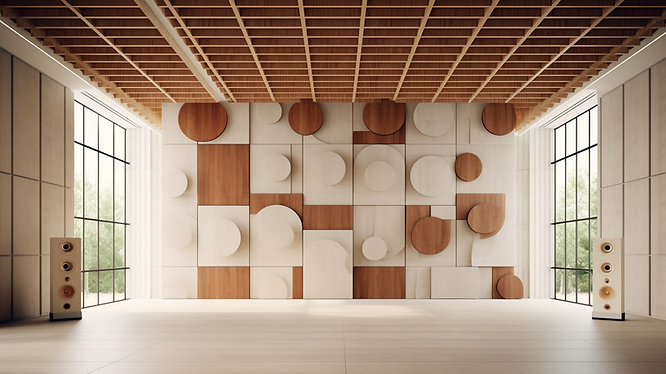Key Takeaways:
- Acoustic panels improve sound quality by absorbing sound waves and reducing reverberation.
- Installing acoustic panels brings benefits such as improved speech intelligibility, reduced background noise, and enhanced audio experiences.
- Modern acoustic panels come in innovative designs and offer customization options to match any interior decor.
- Acoustic panels are ideal for spaces with hard surfaces and can be installed in home theaters, offices, classrooms, and other areas.
- Individuals can choose between DIY or professional installation, with each approach having its own pros and cons.
- Proper installation and maintenance, including strategic panel placement and regular cleaning, are important for optimal performance.
- Acoustic panels can be used creatively in home theaters, offices, and other spaces, serving as both functional and artistic elements.
- Enhancing Acoustics: How Acoustic Panels Improve Sound Quality
The Science of Sound Absorption
Acoustic panels are not just decorative elements; they serve a crucial purpose in improving the sound quality of a space. The science of sound absorption is at the core of how acoustic panels work. When sound waves reach a surface, they can either be absorbed, transmitted, or reflected. In the case of acoustic panels, their design and material composition allow them to absorb sound waves, reducing reverberation and echo in a room.
Acoustic panels are typically made from materials with high sound absorption coefficients, such as foam, fabric, or fiberglass. These materials are specifically chosen for their ability to reduce sound reflections and dampen noise. When sound waves hit the surface of the panels, they penetrate the material and get trapped within the foam or fibers, minimizing the amount of sound that bounces back into the room.
Benefits of Installing Acoustic Panels
The installation of acoustic panels brings numerous benefits to any space, making them an essential element for both residential and commercial settings. One of the primary advantages is improved speech intelligibility. By reducing reverberation and echo, acoustic panels enhance clarity, allowing for better communication in classrooms, conference rooms, or any area where speech is important.
Additionally, acoustic panels create a more pleasant and comfortable acoustic environment by reducing background noise and improving sound quality. This is especially valuable in open-plan offices or noisy environments where concentration and productivity are crucial.
Furthermore, acoustic panels contribute to better audio experiences in home theaters, recording studios, and music rooms. By minimizing sound reflections, they enhance the overall clarity and immersion of the audio, ensuring that every note and sound effect is heard as intended.
- Design Matters: Creating Aesthetic Appeal with Acoustic Panels
Innovative Designs for Modern Spaces
Acoustic panels have come a long way from their humble beginnings as plain, functional soundproofing devices. Today, they can be found in an array of innovative designs that cater to the modern aesthetic. From geometric patterns to custom artwork, acoustic panels can now blend seamlessly with any interior design style.
Modern acoustic panels often feature sleek and slim profiles, allowing them to be discreetly mounted on walls or ceilings without overwhelming the space. Some panels even have built-in LED lighting, adding an extra touch of sophistication to the room.
Customization Options for Personalized Style
One of the advantages of acoustic panels is their versatility in terms of customization. They can be tailored to suit the unique style and preferences of individuals or businesses. Many manufacturers offer a wide range of fabric choices, colors, and patterns, allowing for endless design possibilities.
Custom-printed art acoustic panels are available for those looking for a truly personalized touch. These panels can feature artwork, photographs, or branding, turning them into functional pieces of art that enhance the aesthetic appeal of any space.
Integrating Acoustic Panels with Existing Decor
Acoustic panels are designed to seamlessly integrate with existing decor, ensuring that they do not disrupt the overall style of a room. They can be mounted on walls or ceilings without the need for extensive renovations, making them a convenient option for both homeowners and businesses.
When selecting acoustic panels, it is essential to consider the color and texture of the panels to complement the surrounding environment. With a vast selection of fabric options available, it is easy to find panels that match or enhance the existing color palette and design elements of a space.
- Practical Considerations: Where and How to Install Acoustic Panels
Key Areas in Need of Acoustic Treatment
While acoustic panels can be beneficial in any room, there are certain areas that can benefit the most from their installation. Spaces with hard surfaces like tiled floors, concrete walls, and glass windows tend to have high sound reflection and reverberation, making them ideal candidates for acoustic treatment.
Common areas that can benefit from acoustic panels include home theaters, recording studios, conference rooms, restaurants, classrooms, and open-plan offices. These spaces often have high occupancy or require precise sound reproduction, making acoustic panels essential for improving the sound quality and creating a comfortable environment.
DIY vs. Professional Installation: Pros and Cons
When it comes to installing acoustic panels, individuals have the option to tackle the project themselves or hire professionals. Both approaches have their pros and cons.
DIY installation can be a cost-effective solution, especially for those with a limited budget. Many acoustic panels are designed for easy installation, with adhesive backing or mounting hardware included. However, it is essential to follow the manufacturer’s instructions carefully to ensure proper installation and maximize the effectiveness of the panels.
On the other hand, professional installation guarantees optimal placement and configuration of the acoustic panels. Acoustic professionals have the knowledge and expertise to assess the sound characteristics of a space and determine the most effective placement of panels. They can also handle any challenges that may arise during installation, ensuring a seamless and efficient process.
Tips for Proper Installation and Maintenance
Whether you choose to install acoustic panels yourself or hire professionals, there are essential tips to keep in mind to ensure proper installation and long-term maintenance.
Firstly, it is crucial to follow the manufacturer’s guidelines for panel placement and spacing. Proper positioning of the panels can significantly impact their effectiveness in absorbing sound waves. Placing the panels strategically in areas of high sound reflection will yield the best results.
Regular maintenance is also important to keep acoustic panels in optimal condition. Dust and dirt can accumulate on the surface of the panels, reducing their effectiveness. It is recommended to vacuum or gently wipe the panels with a soft cloth regularly.
Additionally, it is essential to inspect the panels for any signs of damage or wear. If any panels appear damaged or worn out, they should be replaced promptly to maintain the desired sound quality and aesthetic appeal.
- Beyond Functionality: Creative Uses for Acoustic Panels
Acoustic Panels in Home Theaters for Immersive Audio
Home theaters are a popular space for installing acoustic panels, as they significantly enhance the audio experience. By reducing sound reflections and echo, acoustic panels create a more immersive environment, allowing viewers to fully enjoy movies, TV shows, or gaming sessions.
Strategically placing acoustic panels around the room can help create a balanced soundstage, ensuring that the audio is evenly distributed and free from distortion. This allows viewers to hear every detail, from subtle whispers to thundering explosions, as intended by the filmmakers.
Creating Quiet Spaces with Acoustic Panels in Offices
In busy office environments, noise can be a significant distraction and hinder productivity. Acoustic panels offer an effective solution for creating quiet spaces where employees can focus and concentrate.
By absorbing sound waves and reducing background noise, acoustic panels help create a more peaceful and productive work environment. They can be installed in individual workstations or meeting rooms to provide a more acoustically controlled area, minimizing distractions and improving workflow.
Acoustic Panels as Artistic Statement Pieces
With their customizable design options, acoustic panels can also serve as artistic statement pieces in both residential and commercial settings. By choosing panels with unique patterns, colors, or custom prints, they can become focal points that enhance the visual appeal of a room.
In art galleries or exhibition spaces, acoustic panels with artwork printed on them can not only improve sound quality but also showcase the work of talented artists. In homes, custom-printed panels can reflect the individual style and personality of the homeowner, adding a personal touch to the space.
In conclusion, acoustic panels have evolved into both functional and decorative elements that can transform a space’s sound quality and aesthetic appeal. By absorbing sound waves and reducing reverberation, acoustic panels enhance speech intelligibility, improve audio experiences, and create comfortable environments. With a wide range of designs and customization options available, they seamlessly integrate with any interior decor. Proper installation and maintenance are essential to maximize their effectiveness, and they can be installed DIY or professionally. In addition to traditional uses in home theaters and offices, acoustic panels can also serve as creative solutions for immersive audio experiences and artistic statements. Embracing the art of acoustic panels can truly elevate a space, providing both sound and style benefits.
FAQ
Question: What are acoustic panels?
Answer: Acoustic panels are materials specifically designed to absorb sound waves, reducing reverberation and echo in a space.
Question: What are the benefits of installing acoustic panels?
Answer: Installing acoustic panels brings benefits such as improved speech intelligibility, reduced background noise, and enhanced audio experiences.
Question: How do acoustic panels work?
Answer: Acoustic panels are made from materials with high sound absorption coefficients. When sound waves hit the surface of the panels, they penetrate the material and get trapped within, minimizing sound that bounces back into the room.
Question: Can acoustic panels enhance the aesthetic appeal of a space?
Answer: Yes, acoustic panels now come in innovative designs that cater to the modern aesthetic. They can blend seamlessly with any interior design style and offer customization options for personalized style.
Question: Where should I install acoustic panels?
Answer: Acoustic panels are ideal for spaces with hard surfaces, such as home theaters, offices, classrooms, and restaurants. These spaces often have high sound reflection and reverberation, making them ideal candidates for acoustic treatment.
Question: Should I install acoustic panels myself or hire professionals?
Answer: Both approaches have their pros and cons. DIY installation can be cost-effective, but professional installation guarantees optimal placement and configuration of the panels.
Question: How should I maintain acoustic panels?
Answer: Regular maintenance is important to keep acoustic panels in optimal condition. It is recommended to vacuum or gently wipe the panels with a soft cloth regularly. Inspecting for damage or wear and replacing damaged panels promptly is also necessary.
Question: Can acoustic panels be used creatively?
Answer: Yes, acoustic panels can serve as both functional and artistic elements. They can be used in home theaters for immersive audio experiences, in offices to create quiet spaces, and as artistic statement pieces in both residential and commercial settings.
Useful Resources:
- Acoustics.com – Website dedicated to the science and art of acoustics, providing educational resources and information about acoustic panels.
- Soundproof Cow – A comprehensive resource for soundproofing and acoustic solutions, offering educational articles and a variety of acoustic panel options.
- Acoustical Surfaces – Supplier of a wide range of acoustic products, including panels, and an informative website on sound control and acoustics.
- Owens Corning – A leading manufacturer of building materials, including acoustic panels. Their website provides information on acoustic solutions and their products.
- GIK Acoustics – Specializes in designing and manufacturing acoustic panels, offering educational resources and personalized acoustic solutions.
- Acoustic Fields – Offers educational resources and consulting services for room acoustics and sound treatment, including acoustic panels.
- Sound On Sound – A popular music production website with articles and guides on acoustics, including tips on using acoustic panels in recording studios and home theaters.
- ProSoundWeb – A professional audio resource with articles and forums discussing the use of acoustic panels and their impact on sound quality in various applications.









Leave a Reply